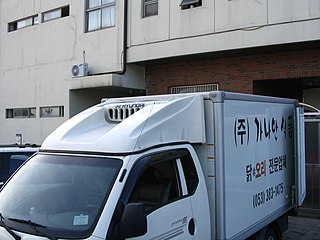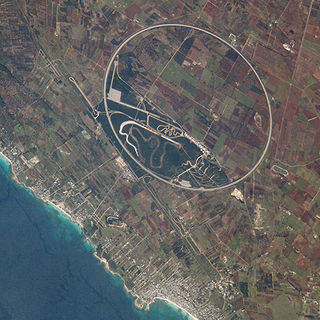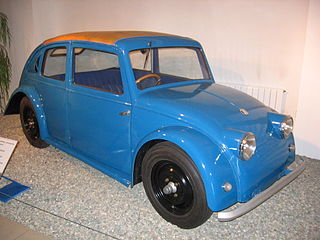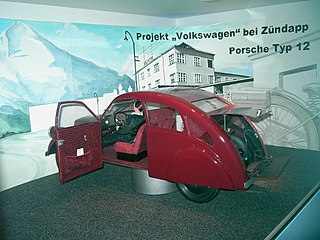
The Volkswagen Golf is a compact car/small family car (C-segment) produced by the German automotive manufacturer Volkswagen since 1974, marketed worldwide across eight generations, in various body configurations and under various nameplates – including as the Volkswagen Rabbit in the United States and Canada, and as the Volkswagen Caribe in Mexico (Mk1).

Automotive aerodynamics is the study of the aerodynamics of road vehicles. Its main goals are reducing drag and wind noise, minimizing noise emission, and preventing undesired lift forces and other causes of aerodynamic instability at high speeds. Air is also considered a fluid in this case. For some classes of racing vehicles, it may also be important to produce downforce to improve traction and thus cornering abilities.

The Volkswagen Jetta is a compact car/small family car manufactured and marketed by Volkswagen since 1979. Positioned to fill a sedan niche above the firm's Golf hatchback, it has been marketed over seven generations, variously as the Atlantic, Vento, Bora, City Jetta, Jetta City, GLI, Jetta, Clasico, and Sagitar.

The Volkswagen Lupo is a city car that was produced by the German car manufacturer Volkswagen, from 1998 to 2005. It shares most of its aspects with the Volkswagen Group's SEAT Arosa, both derived from the Volkswagen Polo Mk3 platform. Main differences are found in styling and equipment. The Lupo name is Latin, meaning wolf, and is named after its home town of Wolfsburg.

The SEAT León, also spelled Leon in some other languages, is a hatchback compact car built by the Spanish car manufacturer SEAT since October 1999.

The Volkswagen Passat is a series of large family cars (D-segment) manufactured and marketed by the German automobile manufacturer Volkswagen since 1973, and currently in its ninth generation. It has been marketed variously as the Dasher, Santana, Quantum, Magotan, Corsar and Carat. The successive generations of the Passat carry the Volkswagen internal designations B1, B2, etc.

The Audi 100 and Audi 200 are primarily mid-size/executive cars manufactured and marketed by the Audi division of the Volkswagen Group. The car was made from 1968 to 1997 across four generations (C1–C4), with a two-door model available in the first and second generation (C1-C2), and a five-door model available in the last three generations (C2–C4).

The Volkswagen XL1 is a two-person limited production diesel-powered plug-in hybrid produced by Volkswagen. The XL1 car was designed to be able to travel 100 km on 1 litre of diesel, while being both roadworthy and practical. To achieve such economy, it was produced with lightweight materials, a streamlined body and an engine and transmission designed and tuned for economy. The concept car was modified first in 2009 as the L1 and again in 2011 as the XL1.

The Porsche 114 was a 1938 proposed design for a sports car powered by a 1493 cc V10 engine.

The Nardò Ring, originally known as Pista di prova di Nardò della Fiat when it was built in 1975, is a high speed test track located at more than 23 kilometres (14 mi) north-west of the town of Nardò, Italy, in the southern region of Apulia, in the Province of Lecce. It was acquired by Porsche Engineering in 2012 from its former owners, Prototipo SpA. Porsche now calls the site Nardò Technical Center.

The Rumpler Tropfenwagen was a car developed by Austrian engineer Edmund Rumpler.

The Volkswagen Golf Plus is a car that was manufactured by Volkswagen between 2004 and 2014. As a five-seater compact MPV (C-segment), it was developed as a taller alternative to the Golf hatchback and positioned below the seven-seater Touran in Volkswagen's product catalogue, the vehicle is based on the Golf Mk5, riding on the PQ35 platform. An alternative appearance package was sold as the Volkswagen CrossGolf in 2006. Throughout its life cycle, it has been sold alongside the Golf Mk5 and Golf Mk6.

The Volkswagen Logus was a rebadged Ford Escort MkV launched by Volkswagen in a two-door coupé configuration in March 1993, as part of the Ford Motor Company and Volkswagen do Brasil joint venture in South America called AutoLatina. The Logus was designed in the Ghia Studios in Italy under the stewardship of Luiz Alberto Veiga from Volkswagen do Brasil.

The Volkswagen Polo Mk4 is the fourth generation of the Volkswagen Polo supermini car produced by the German manufacturer Volkswagen. It was marketed from early 2002 to 2009 in most countries except Argentina and the USA. It was manufactured in South Africa until 2017, it was sold as the Polo Vivo. The Mk4 replaced the Volkswagen Polo Mk3, while the Polo Vivo replaced the Citi Golf. In 2018 the Mk4 was replaced by the Volkswagen Polo Mk5 Polo Vivo. In Brazil, It was manufactured until 2014 with a second facelift called 9n4, It was replaced in 2017 by Volkswagen Polo Mk6.

The Tatra V570 was a prototype 1931-33 car developed by a team led by Hans Ledwinka, Erich Ledwinka and Erich Übelacker. The aim of the construction team was to develop a cheap people's car with an aerodynamic body. The first T57-V570 prototype with rear air-cooled two-cylinder engine placed in the former rear luggage compartment of conventional T57 two-seater droped head coupe was completed late in 1931. However, the company's management decided that the revolutionary ideas introduced in the prototype should be introduced in large luxurious cars, and therefore the team abandoned the project of small cars in favour of the Tatra T77, the world's first serially produced aerodynamic car. The project of a small car was later continued and led to introduction of the Tatra T97. The second, now streamlined V570 four-seater was built in 1933, two years before the first Volkswagen, which bears a strong resemblance to the Tatra – it was misappropriated in the opinion of Tatra, by Adolf Hitler and Dr. Ferdinand Porsche in circumstances about which the German company remains intensely sensitive.

The third-generation Volkswagen Passat, known as Volkswagen Passat B3 or Volkswagen Passat 35i, was introduced in March 1988 in Europe, 1989 in North America, and 1995 in South America; it was also briefly available in Australia in 1991, when a total of 14 Passat GL 16V in sedan and wagon versions were sold by then importer TKM. Unlike the previous two generations of the Passat, the B3 was not available as a fastback - only 4-door sedan and 5-door station wagon versions were available, setting the precedent for the model for all subsequent generations to date. Its curvy looks were a contrast from the boxy appearance of its predecessor and owed much to the "jelly mould" style pioneered by Ford with the Sierra and Taurus. The lack of a grille, utilizing the bottom breather approach, made the car's front end styling reminiscent of older, rear-engined Volkswagens such as the 411, and also doubled as a modern styling trend. The styling was developed from the 1981 aerodynamic Auto 2000 concept car.

The Volkswagen Golf (Mk7) is a small family car (C-segment) manufactured by German automobile manufacturer Volkswagen. It is the seventh generation of the Golf and the successor to the Golf Mk6. It was introduced at Berlin on 4 September 2012, before a public launch at the 2012 Paris Motor Show. Sales in Europe began with the model in November 2012.

The Porsche Type 12 was a German project to develop an "Everyman's automobile" for Zündapp. Fritz Neumeyer, then owner of Zündapp, ordered Ferdinand Porsche to design and build the prototype in 1931. Eventually, two saloons, and one drophead coupé were built. All of those cars were lost during World War II, the last one in a bombing raid in Stuttgart in 1945. The Type 12 is considered an important early step in the development of the original Volkswagen. A replica of the Type 12 is on static display at the Museum Industrielkultur in Nürnberg.
The Formula Volkswagen Germany was a short-lived single-seater category in Germany between 2001 and 2003.

The Volkswagen Auto 2000 is a concept car first shown by German car company Volkswagen in 1981. It was part of a German government-sponsored program to develop cars for the year 2000. Volkswagen's prototype was joined by efforts from Audi, Mercedes-Benz, and the University Working Group HAG (Hochschularbeitsgemeinschaft). As with the other Auto 2000 concepts, Volkswagen's car focused on fuel economy through the use of efficient engines and streamlining, and many of its features were to end up in series production.





















